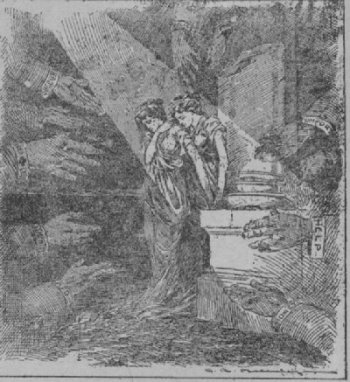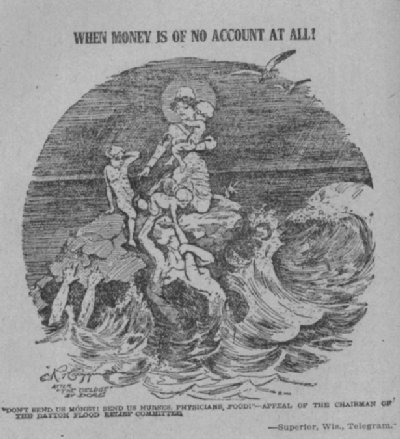WHAT TO DO AFTER A FLOOD
 |
After the flood comes the aftermath. In a flooded district the waters rage, destroying lives and property for a few days. Then they drop back to their accustomed channels, and contagion rages, destroying lives and health for a few weeks.
The aftermath is, too, a product of the flood. Scarlet fever, diphtheria, smallpox, and other forms of active contagion are increased because the regular methods and customs of the community are disturbed. In the excitement and daze, quarantines are not kept and many more people are exposed than in normal times. Typical cases that in orderly times would stay at home and be on the safe side, mingle with the mad rush of fleeing people, or gather in the idle crowds of sightseers.
These are the reasons, and not street filth, why there is an aftermath of contagion. This group of diseases usually flares up about a week after the flood begins and they are at their worst about three weeks later.
There will be some pneumonia aftermath. The colds that come from the damp walled houses will show up within a day after the people have moved back. Some pneumonia will develop within a day.
Pneumonia differs from typhoid fever in that the disease comes within a few hours after the germs get into the blood, whereas, in typhoid they stay in the system a week before the sickness starts.
However, some of the colds that start the first night in the wet house will not develop into pneumonia for three or four days. The pneumonia germs in the nose and throat cause colds; in the blood, cause pneumonia.
In the Chicago tuberculosis exhibit are graphic pictures of wet-footed houses and the harm done by them. In the flood districts the houses are more than wetfooted; they are wet through and through.
The remedy? Thorough cleansing, emptying the basements of water, washing of floors, sinks and toilets with a chlorinated lime or carbolic mixture.
To make a solution of chlorinated lime for washing, pour a pound of the powder from a tin can into half a barrel of water. To make a solution of one of the crude carbolic preparations, put a tablespoonful in a gallon of water.
Above all, heat, sun and air the house and its contents and repeat day after day.
Much of the most important of the flood aftermaths are typhoid fever and diarrhœas. The stench from dirt and decaying matter in the streets and the yards is objectionable, but not of much consequence as compared with the pollution of the water.
Frequently the wells or reservoirs are located in low places and the flood waters cover them. This happened at Peru this year and last year at Memphis. Frequently a connection from the reservoir-well to the sewers, provided to prevent the wells from overflowing, will carry sewage from the sewers to the well. This happened at Mankato.
Frequently a town uses the unfiltered water from some normally fairly safe stream, but a stream which, in flood times, is heavily polluted. Frequently the people who live on the flats habitually use water from dug wells and, in times of flood the yards, vaults and stables are emptied into these wells.
Some part of the typhoid is due to the washing of milk utensils in the polluted water. Some part of it is due to the general disarrangement of the habits and customs of the people, subjecting them to a miscellaneous lot of typhoid foci.
The remedy? Influence just as many people as possible to boil or chlorinate their drinking water. By boiling is meant to heat the water until it starts to simmer. The typhoid germ is killed by a temperature of 160 degrees, 50 degrees below boiling.
To chlorinate, put a teaspoonful of chlorinated lime in three teacups of water. Put one teaspoonful of this solution in two gallons of drinking water.
It is the universal experience that a community that trusts to individual action in boiling the water always pays the penalty of typhoid. Therefore, the proper policy is for the community to treat the water. A temporary chlorine plant of the type proposed by Darnell for the army may be installed. Or chloride of lime may be dissolved in the water at the reservoir or in the well. The amount used when the water is extremely muddy and heavily polluted should be somewhere around thirty to forty pounds a million gallons —as much as the people will stand. As the water gets clearer the quantity may be reduced day by day until it reaches fifteen, or even ten pounds per million gallons. After things have got nearly normal, say ten days after the pollution, it may go to five or even three pounds.
As the people who have dug wells are certain to begin using the water after a week or ten days, the officers should themselves purify this water with chloride of lime. A few barrels and some pipe constitute all the apparatus required. For immediate use the lime may be placed in a gunny sack and dragged through the well. The expense is nominal.
The street department must see that the streets and alleys are cleaned and an ample squad of sanitary police must see that the houses are cleaned.
However, effort in this direction must not divert attention from the main danger, namely, polluted water and milk. What is on the floor is bad, but what gets in you is a million times worse.
Finally, the wise people in a flood area will get vaccinated against typhoid. Vaccination saved Memphis in 1912.
 |
—Superior, Wis., Telegram. |
Continue
Back
Back to Legacy
© 2001, Lynn Waterman